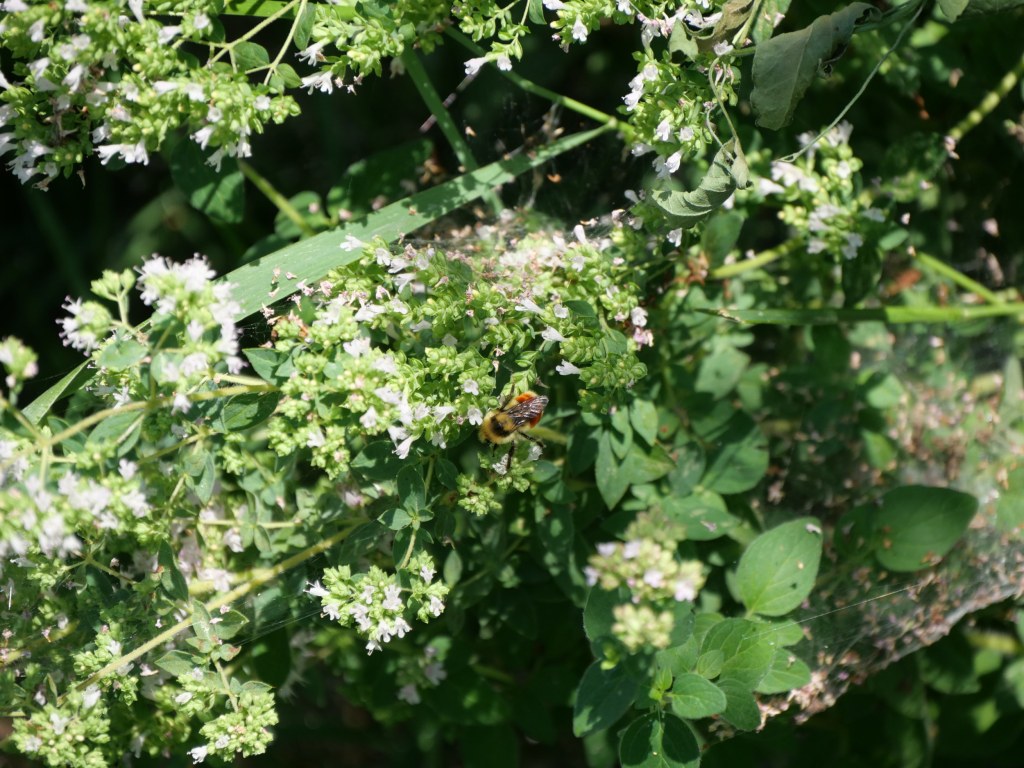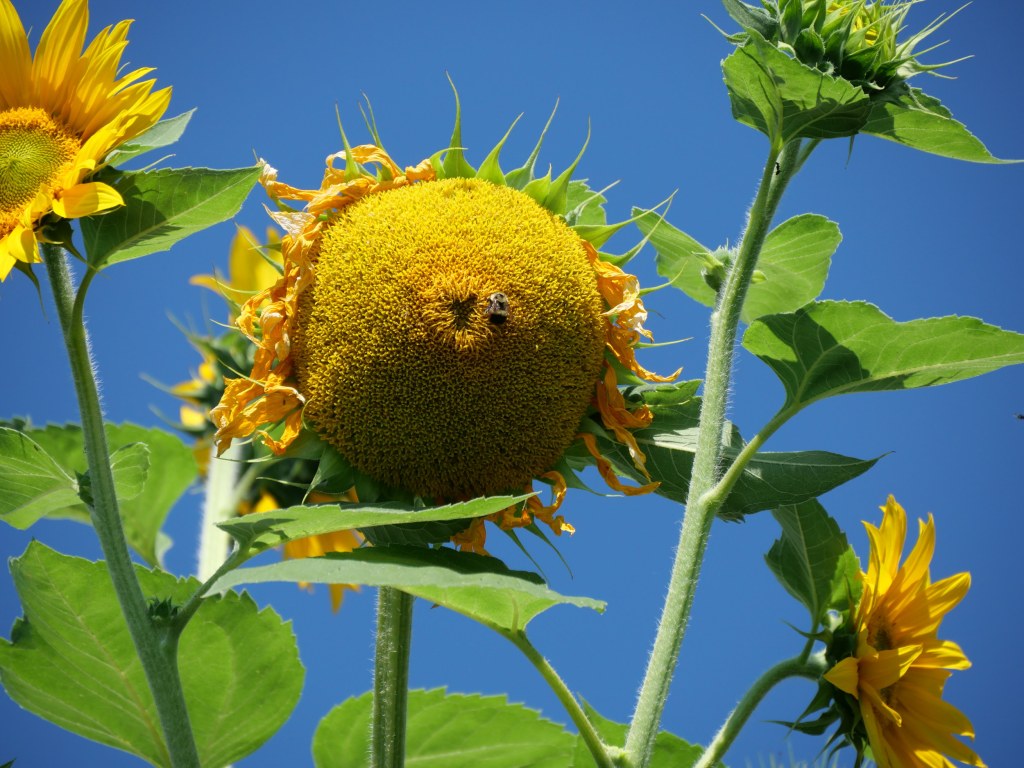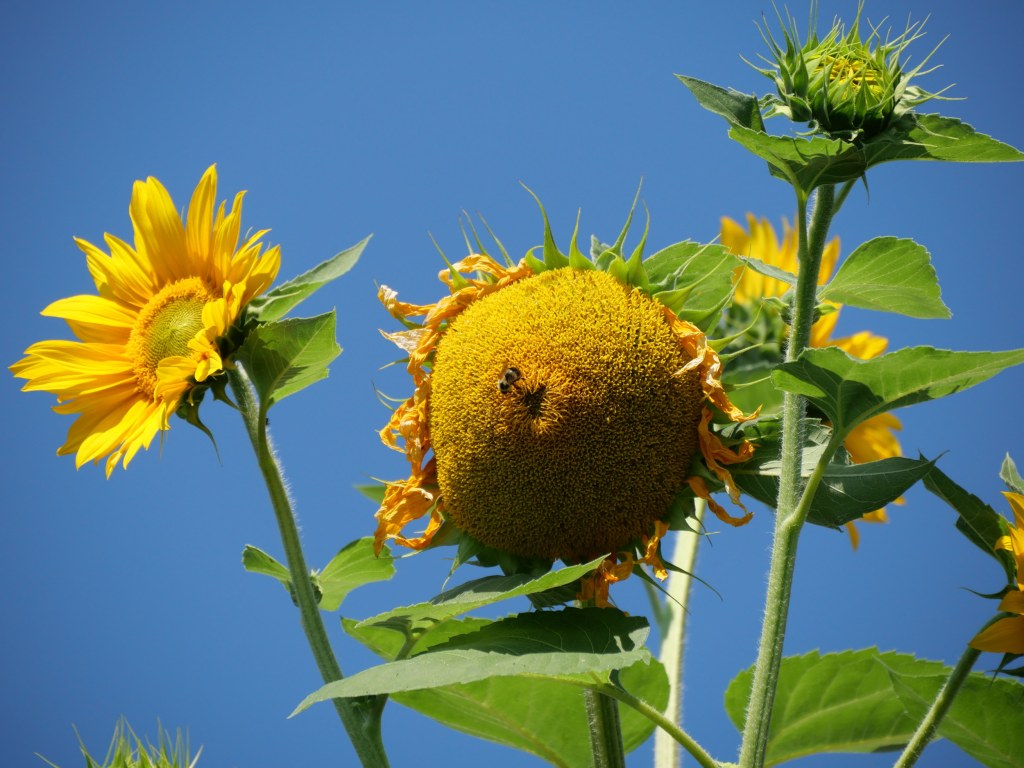This blog started in 2011 as a research tool for writing about the environment of the Intermontane Grasslands of Cascadia, especially in terms of demonstrating the power of the landscape to harvest, store and move the energy of the sun as an alternative to the seductive technologies of nuclear fission reactors. Here, on my 3,000th post, is some oregano hard at work harvesting the sun today, and covered with bees. Here’s a little miner bee harvesting.
I have learned so much, not the least of which is that my method, to record observations with a camera and then to grow into them over time has changed my life. Here’s another little bee come down from the grasslands, today. There’s little left for them today, but I have learned that there is hope, or maybe I’ve always had hope and have learned to share it.
Bees are dying for many reasons, including herbicide and pesticide applications but also well-meaning but inappropriate attempts to conserve water by turning grassland hillsides into slopes of bare, crushed rock. Still, even cabbage moths came to the oregano today. I had hundreds of visitors any minute, and that for a week now, and that on only about a square metre of oregano, divided into four blocks.
That’s how rich the Earth is. This is how much of the sun is being harvested any minute. Let the honeybee below bear witness. I have learned that it is more important to plant oregano than it is to write lush poems about bees. That’s hard knowledge, but what it really means is that poems can be published for bees, rather than for humans.
There is respect in this, not only respect from me to the bees, but respect back. I have travelled through much of Cascadia on this project, and have published one book, The Tree Whisperer, that comes from this exploration. I have two more underway, one a book about the energy relationship of Sun and Earth, provisionally called Fission Reactor Handbook: Northeast Pacific Region, and one a history of this basalt sea set within the Indian Wars of American Oregon, and the work of the Catholic Church in that visciously-contested territory. It is called Okanagan Okanogan, just like this blog.
I started this project after a publisher (a friend, too) told me that my manuscript about returning to the Okanagan in 2011, Back to the Interior, which included appreciations of Indigenous ways of knowing, including trickster humour, which comes naturally to me, was childish. I realized I had to demonstrate, for awhile, what it is to be of a place. Well, 11 years later, I am more intensely of the place, and less connected to the Canadian or literary world. After all, to whom else is this oregano bush a poem? All day, I’ve been watching bees feast, get tangled in webs, and kick themselves free, even wrestle their way through them. Some haven’t made it, as you can see by the wreckage below.
It’s not much in the world of Search Engine Optimization, but 332,433 of you have stopped by. I am sure glad you have. I hope some of my love has carried across this strange media interface. It is freely given. I could have made about $4 a year in ad revenue at that rate. Instead, I have spent 10s of 1000s of hours, as many dollars, have put up a couple hundred thousand images, and have plowed through 5 cameras. My latest went out to the oregano today. This is one of the first honeybees I have seen all year. Usually, it has been wild bees and wasps, most smaller than a grain of rice. Most smaller than a grass seed. Just this month, more than 332,433 of you have stopped by.
Another manuscript I am working on from this blog is a dictionary of environmental language. Early research on it was in my blog The Green Earth Dictionary. My recent book of poems, Landings: Poems from Iceland, took a small part of that language and worked it out as a way of speaking with the world. It is not contemporary poetic practice to include the Earth or its creatures as speakers, and it is the approach that had my work mocked as childish, but it is an indigenous approach. Right now, the indigenous environment of the Okanagan Valley is in catastrophic decline. Today, though, my oregano is a light, bringing people in from far and wide. It was always one of my goals to be as practical as possible, given that poets are often mocked as impractical people, children even. Practically speaking, then, imagine if there were a hundred square miles of oregano along the roadsides of the Okanagan, replacing barren gravel landscaping and institutional cedars and all the whatnot that is meant to be low maintenance and sterile. The bees would not be in crisis. It would cost us nothing. That’s what we can do. That’s how powerful simple things can be. That’s how much hope we can muster. It’s a lot. The sunflowers above the oregano, too. I don’t plant these for myself, but for the bees and the birds, but, of course, where would I be if not surrounded by bees and birds?
So, yeah, I’m looking after myself, too.
That’s how a gift economy, an indigenous form of economic organization, works. But 3,000 posts! That’s crazy stuff. Some have taken me a couple minutes. Most have taken an hour. Many, many of them have taken me 8-12 hours of work. Again, thank you for coming by and enriching my life. I couldn’t have clogged up Google searches on the Okanagan alone. There are ironies. During these 11 years, the publishing world has changed. Books like the ones I set out to research and write are no longer the sort of thing the world wishes to publish or read. It’s an urban world now. Social interactions between humans are key now. With that in mind, look to the next year as a year of renewal and transformation for this blog, as I rejig the website, start methodically publishing Okanagan Okanogan here, categorize all my old posts to make them more accessible, and bring in the dictionary. I will still post new images and observations, but it’s time to share, not what I have found but what it has lead me to, socially, politically, artistically and environmentally, because this is serious and it matters that we all walk together back to the Earth. It’s hard, but let’s do it together. Here’s the bee on her second circle, first one way and then the other.
Thank you all for your support on this long journey. First we’ve gone one way (or about 11), and then another. I hope you’ll hang around. Don’t be shy. I need you all. Blessed be.
Categories: Earth Science, Ethics, First Peoples, flower gardening, Gaia, Grasslands, green technology, Herbs, landscaping, Nature Photography, Other People, Science, Spirit, Urban Okanagan
























Your work has had a big influence on me. Thank you, Harold.
(About bees–domestic and wild–phacelia, poppies, male hemp (for pollen)–are “my oregano.”
LikeLike
Thanks for the pollinator tips! Glad you are part of this project!
LikeLike
Beautiful post. Thank you.
LikeLike
Thanks, Mickie!
LikeLike
Looking forward to the next 11: we need ’em all. Thank you for this essential grounding. Just fund some stray oregano I thought was lost!
LikeLike
Looking forward to the next 11: we need ’em all. Thank you for this essential grounding @HaroldRhenisch. Just found some stray oregano I thought was lost!
LikeLiked by 1 person
Oregano is sneaky! Thanks for the blessings.
LikeLiked by 1 person
Harold, I’m so grateful that I found your blog 5 years ago. Your knowledge and perspective is most appreciated. Keep on writing. Poets are the souls of humanity. Many blessings for years to come.
LikeLike
Thanks for the blessing! I hope to do this for a long time, too.
LikeLike
Looking forward to the evolution.
Keep up the fascinating and visionating.
LikeLike
Thanks, Robert. I look forward to sharing the history in depth.
LikeLike
Harold, this is a masterpiece, not because it is 3000 posts, not because it has to fit into the hierarchy of literature, but because you have voyaged so deeply into the places and spaces that we live in here. We are children in so many ways that we interact with this Earth. Thank you for what you have shared, which has helped me on the way, falling and getting up and failing often still, out of this childhood. Claude
LikeLike
Thanks, Claude. It means a lot to hear this from you. I fall and get up, too. You make good company.
LikeLike
Congratulations on 3000! Your words and ideas continue to captivate.
LikeLike